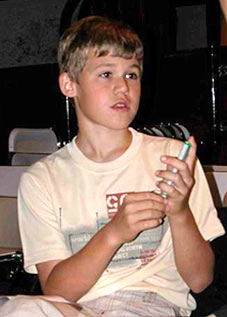


ChessBase 17 - Mega package - Edition 2024
It is the program of choice for anyone who loves the game and wants to know more about it. Start your personal success story with ChessBase and enjoy the game even more.
5th Lausanne Young Masters – September 15-20, 2004
Photos from the official site
 Final Standings
Final Standings
He's only a year into his studies at Oxford – mathematics and philosophy – but Luke McShane just graduated the Lausanne Young Masters tournament with honors. He duplicated last year's win by beating top seed Mamedyarov in the final match.
It wasn't as smooth as the 20-year-old might have hoped. His semifinal match against European champion David Navara was a nail-biter after McShane lost the first game with white in a 75-move grind. But McShane is blessed with the unique English chessplayer's knack for sharp, offbeat defenses (American Joel Benjamin is an honorary member). He struck back with a double-fianchetto that quickly turned into tactical insanity very quickly. That leveled the score and McShane went through in the rapid playoff. (Where McShane again won with black in the same opening line.)

Kateryna Lahno, Shakhriyar Mamedyarov, Alexandra Kosteniuk
 In the final McShane stuck to the more traditional formula of draw with black, win with white. Mamedyarov missed several chances to draw in an endgame, but McShane gets all the credit for pushing hard all the way through and finding several excellent moves. (See analysis below.)
In the final McShane stuck to the more traditional formula of draw with black, win with white. Mamedyarov missed several chances to draw in an endgame, but McShane gets all the credit for pushing hard all the way through and finding several excellent moves. (See analysis below.)
Many eyes were on the youngest participants, particularly 13-year-old Magnus Carlsen of Norway. He lost in the rapid tiebreak to Alekseev in the first round, which put him down in the second half of the table. After that he won his matches against Papa and a marathon against 15-year-old Kateryna Lahno to finish fifth.
After the event Carlsen said he was content that he would break the 2600 Elo mark on the next rating list. When asked by an interviewer he said his favorite players are Fischer and Anand.
Alexandra Kosteniuk had a forgettable event, not winning a single game or even making it to a tiebreak. Next year McShane will be too old to play in the event so someone else will at last have a chance to win. Something makes us think that Carlsen won't need the six or seven tries he's eligible for.
|
This was the decisive game of the final match. The diagram was the last chance for Black to salvage a half point and force a tiebreak. McShane's knight worked wonders to keep the pressure on. Mamedyarov can't take on d5 because of Nf6+, so he took the b-pawn instead. 58...Kxb5?? 59.Kd4! The subtlety that Black had missed, as he admitted after the game, keeping the black king off of c5. (59.Nxd6? is a draw after 59...Kc5 60.Ne4+ Kxd5!= and the king can stop the h-pawn while the white king has to stop the queenside pawns.) Now white gets two passed pawns and that's more than the bishop can handle. Black actually has two moves to draw in the diagram, the idea being the same. The clearest is 58...a5, quickly creating his own passed pawn. (58...a6 also works.) 59.Nxd6 Kxd5 60.Nxb7 a4 61.Kd2 Kc4 62.b6 Kb5= |